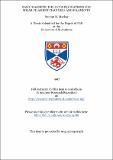Files in this item
Basic magnetic field configurations for solar filament channels and filaments
Item metadata
| dc.contributor.advisor | Priest, E. R. (Eric Ronald) | |
| dc.contributor.author | Mackay, Duncan Hendry | |
| dc.coverage.spatial | 179 p. | en_US |
| dc.date.accessioned | 2018-06-18T11:35:14Z | |
| dc.date.available | 2018-06-18T11:35:14Z | |
| dc.date.issued | 1997 | |
| dc.identifier.uri | https://hdl.handle.net/10023/14188 | |
| dc.description.abstract | The three-dimensional magnetic structure of solar filament channels and filaments is considered. A simple analytical potential model of a filament channel is setup with line sources representing the overlying arcades and point sources the flux of the filament. A possible explanation of the distinct upper and lower bounds of a filament is given. A more detailed numerical force-free model with discrete flux sources is then developed and the effect of magnetic shear on the separatrix surface explored. Dextral channels are shown to exist for a wider range of negative values of the force-free alpha and sinistral channels for positive values of alpha. Potential models of a variety of coronal structures are then considered. The bending of a filament is modelled and a method of determining the horizontal component of a filament's magnetic field is proposed. Next, the observed opposite skew of arcades lying above switchbacks of polarity inversion lines is shown to be produced by a local flux imbalance at the corner of the switchback. Then, the magnetic structure of a particular filament in a filament channel is modelled using observations from a photospheric magnetogram. It is shown that dips in the filaments magnetic field could result from opposite polarity fragments lying below the filament. Finally, the formation of a specific filament channel and filament is modelled. The formation of the channel is shown to be due to the emergence of new flux in a sheared state. It is shown that convergence and reconnections between the new flux and old remnant flux is required for the filament to form. The field lines that represent the filament form a thin vertical sheet of flux. The changing angle of inclination of the sheet gives the appearance of twist. The method of formation is then generalised to other cases and it is shown that a hemispheric pattern consistent with the results of Martin et al. (1995) can be obtained. | en_US |
| dc.language.iso | en | en_US |
| dc.publisher | University of St Andrews | en |
| dc.subject.lcc | QA927.M2 | |
| dc.subject.lcsh | Magnetohydrodynamics | en |
| dc.title | Basic magnetic field configurations for solar filament channels and filaments | en_US |
| dc.type | Thesis | en_US |
| dc.contributor.sponsor | Particle Physics and Astronomy Research Council (PPARC) | en_US |
| dc.type.qualificationlevel | Doctoral | en_US |
| dc.type.qualificationname | PhD Doctor of Philosophy | en_US |
| dc.publisher.institution | The University of St Andrews | en_US |
| dc.publisher.department | Herzberg Institute of Astrophysics; National Research Council of Canada | en_US |
This item appears in the following Collection(s)
Items in the St Andrews Research Repository are protected by copyright, with all rights reserved, unless otherwise indicated.

